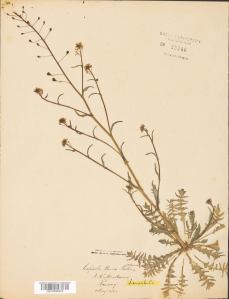by Adriana Lopez-Villalobos and Amelie Mahrt-Smith

Capsella bursa-pastoris may at first appear to be just another weed blending into the sea of fresh spring greenery. But take a closer look at this plant commonly known as Shepherd’s Purse, and you will notice the curious appendages from which it got its name. Its distinctive seed pods – small pouches in the shape of a heart – bear resemblance to an old-fashioned style of purse carried by shepherds in centuries past [6]. This widespread edible weed is a part of the Mustard family, Brassicaceae. This family is shared by garlic mustard (see our previous post about it), thale cress, and many common supermarket vegetables like broccoli and kale. Of the five species in the Capsella genus, C. bursa-pastoris is the only one found in North America, which makes it easier to identify this species in your community.

Shepherd’s Purse is a cosmopolitan weed: it is found all over the world. Its secret weapon is its ability to grow in a wide variety of conditions. It can be found in disturbed ground or dumps, and frequently invades the cultivated soil in gardens and crops. It can grow in full sun or partial shade, dry or moist soils, and even cracks in concrete (Image 1); its hardiness makes it a good contender for urban living [3]. You can identify Shepherd’s purse by its large leaves with irregular lobes at the base of the stem, and smaller, arrow-shaped leaves that clasp the stem. In good conditions, it can reach 60-80 cm tall. Its tiny white clustered flowers have four petals each (with the 6 distinctive stamens: 2 outer short and the 4 inner long). The most identifiable feature is the heart-shaped seed pods attached to the main stem by a long stalk, which makes it distinguishable from similar plants like wild mustard (Image 2) [5]. Early in the spring, Shepherd’s Purse’s flowers begin to bloom, and they will continue to bloom until late fall. It is an annual, which means an individual plant only survives for one year, but several generations can be produced during the warmer months, and a single plant can produce up to 45,000 seeds! This is a high level of production that is facilitated, in part, by their ability to self-pollinate. Instead of waiting for an insect to come by and transfer pollen from one individual to another, the pollen simply fertilizes the flower from which it was produced (or a close neighbouring flower) [4].

C. bursa-pastoris was introduced to North America by European settlers many times over. In the southwestern United States, it hitched a ride with Spanish colonizers, while further north in the U.S. and Canada, we have the British and French colonists to blame [7]. Shepherd’s Purse was once an important European medicinal herb, especially for women. Like many plants, has been overtaken by more effective modern drugs. All its parts are edible and can be used as a peppery seasoning – although we do not recommend you try this with unfamiliar plants! The leaves, which are high in vitamins and minerals, were traditionally made into a tea for the relief of pre-menstrual cramps and to reduce the risk of haemorrhaging after childbirth [1,2]. The Fowler Herbarium at the Queen’s University Biological Station has C. bursa-pastoris specimens collected in Kingston during the 1800s. This beautifully preserved Shepherd’s Purse specimen was collected in 1862 in the former township of Ramsay, Lanark County, which lies between modern-day Kingston and Ottawa. Notice the defining features of C. burasa-pastoris: the larger basal leaves, small stem leaves, heart-shaped seed pods, and clusters of tiny flowers at the tip (no longer white, but you get the idea.
References
- Aksoy, A., Dixon, J.M. and Hale, W.H. 1998. Biological flora of the British Isles. Capsella bursa-pastoris (L.) Medikus (Thlaspi bursapastoris L., Bursa bursa-pastoris (L.) Shull, Bursa pastoris (L.) Weber). Journal of Ecology 86, 171-186.
- Ghalandari, S., Kariman, N., Sheikhan, Z., Mojab, F., Mirzaei, M., and Shahrahmani, H. 2017. Effect of hydroalcoholic extract of Capsella bursa pastoris on early postpartum hemorrhage: A clinical trial study. J Altern Complement Med 23, 794‐799. doi:10.1089/acm.2017.0095
- Grieve, M. 1984. A Modern Herbal. Penguin. New York. ISBN 0-14-046-440-9
- iNaturalist. Shepherd’s purse. iNaturalist. https://www.inaturalist.org/guide_taxa/330084
- Newcomb, L. 1977. Newcomb’s Wildflower Guide (pp. 150). Little, Brown and Company. New York.
- 6. Reader’s Digest Field Guide to the Wild Flowers of Britain. Reader’s Digest. 1981. p. 54. ISBN 9780276002175.
- Neuffer, B., and Hurka, H. 1999. Colonization history and introduction dynamics of Capsella bursa-pastoris (Brassicaceae) in North America: isozymes and quantitative traits. Molecular Ecology 8, 1667-1681.